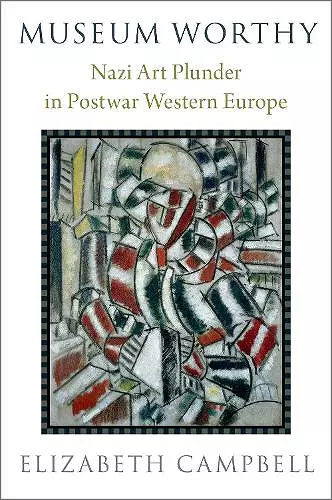Museum Worthy
Nazi Art Plunder in Postwar Western Europe
Format:Hardback
Publisher:Oxford University Press Inc
Published:28th Aug '24
Should be back in stock very soon

Art looting is commonly recognized as a central feature of Nazi expropriation, in both the Third Reich and occupied territories. After the war, the famed Monuments Men (and women) recovered several hundred thousand pieces from the Germans' makeshift repositories in churches, castles, and salt mines. Well publicized restitution cases, such as that of Gustav Klimt's luminous painting featured in the film Woman in Gold, illustrate the legacy of Nazi looting in the art world today. But what happened to looted art that was never returned to its rightful owners? In France, Belgium, and the Netherlands, postwar governments appropriated the most coveted unclaimed works for display in museums, embassies, ministries, and other public buildings. Following cultural property norms of the time, the governments created custodianships over the unclaimed pieces, without using archives in their possession to carry out thorough provenance (ownership) research. This policy extended the dispossession of Jewish owners wrought by the Nazis and their collaborators well into the twenty-first century. The custodianships included more than six hundred works in Belgium, five thousand works in the Netherlands, and some two thousand in France. They included paintings by traditional and modern masters, such as Rembrandt, Cranach, Rubens, Van der Weyden, Tiepolo, Picasso, and Matisse. This appropriation of plundered assets endured without controversy until the mid-1990s, when activists and journalists began challenging the governments' right to hold these items, ushering in a period of cultural property litigation that endures to this day. Including interviews that have never before been published, Museum Worthy deftly examines the appropriation of Nazi art plunder by postwar governments and highlights the increasingly successful postwar art recovery and restitution process.
“Elizabeth Campbell examines the way in which American and European historians have explained the pillage of artworks by the Nazis and how this research has encouraged European museums and public institutions to look at their collections in a new ethical light. Her research examines the various ways in which public collections are seeking just and fair solutions by doing detailed provenance research. Campbell's far-ranging new book not only builds upon Lynn Nicholas's groundbreaking work, The Rape of Europa, but enlarges its scope.” - Emmanuelle Polack, art historian
“A thought-provoking monograph on the transnational history of looted art in the Holocaust. Elizabeth Campbell argues that the main West European museums left the work of restitution intentionally unfinished, in order to enrich their collections. In its comparative approach between France, Belgium and the Netherlands, this book explains why the restitution process of looted art is still ongoing today.” -Jean-Marc Dreyfus, author of The Goering Catalogue
“In Museum Worthy, Elizabeth Campbell offers a sweeping history of the unprecedented art restitution efforts emerging from the Nazi era: from the early Allied campaign of 'Monuments Men' * and she stresses, Womento the most recent litigation concerning high priced Nazi looted art. In her deeper analysis of art restitution in Western Europe and the United States, Campbell explains the frustrations and loss of momentum for many years, but also the tangible and important achievements for Holocaust victims, especially beginning in the mid-1990s. Campbell's nuanced and gripping account helps explain why, after more than 75 years, there is so much unfinished business regarding Holocaust era assets.” -Jonathan Petropoulos, John V. Croul Professor of European History, Claremont McKenna College *
ISBN: 9780190051983
Dimensions: 229mm x 165mm x 43mm
Weight: 658g
360 pages